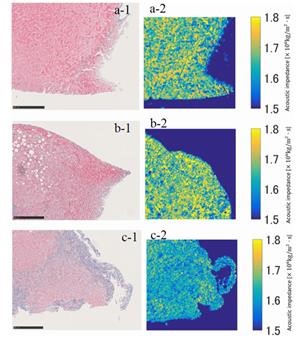Client Publication Announcement / European Radiology Experimental
We would like to introduce an update regarding a new article published by our client in European Radiology Experimental.
Juntendo University
Title: Free fatty acid-based low-impedance liver image: a characteristic appearance in nonalcoholic steatohepatitis (NASH)
This paper examines whether the resistance (impedance) of free fatty acid (FFA) in the liver can be used to discriminate between normal livers, livers with simple steatosis, and the livers of NASH patients.

(Figure .1 Results of Masson trichrome staining of mouse liver and distribution of acoustic impedance)
-Difference between acoustic impedance and FFA content-
The authors of this article utilized our STAM ™ mice as model mice for both simple steatosis and NASH.
The impedance was highest in the normal mouse liver, and showed a gradual decrease in the simple steatosis liver, to a significant decrease in the NASH mouse liver.
In human samples, a remarkable decrease similar to that in mice was confirmed.
The above results indicate that FFA impedance measurement could be applied as an early diagnostic tool for NASH. In the future, the effects of ethnic differences in FFA composition and the degree of liver fibrosis on impedance will be examined.
The FDA’s 2018 drug discovery guidelines for non-cirrhotic NASH established criteria for NASH patients involved in clinical trials. Among them, liver biopsy, an invasive procedure, is regarded the most important and reliable diagnostic item. However, non-invasive methods that can reduce patient burden and enable early diagnosis, such as biomarkers and ultrasonic diagnosis, are also included.
In this paper, a similar trend was identified in STAM ™ mice and human NASH specimens, and it was reported that STAM ™ mice helped pave the way for the establishment of a new noninvasive diagnostic method for NASH.
STAM ™ mice are an excellent platform not only for the development of new diagnostic methods such as this, but also for the development of new drugs, and we believe that this model can support a smooth progression to clinical trials. As well as STAM™, we have a broad model lineup for a wide range of inflammatory and fibrotic diseases.
We are also currently running a limited campaign for screening studies, so if you have any questions or would like further details on our services and study plans, please don’t hesitate to get in touch.
